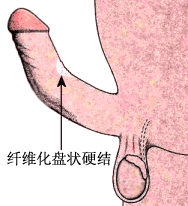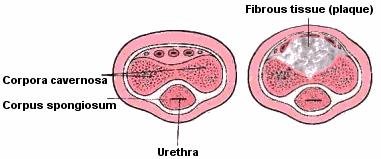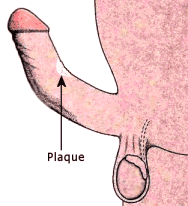|
男性性生理问题
|
|
帕荣雷氏病(阴茎海绵体硬结)
|
|
|
|
François
Gigot
de
La
Peyronie
(1678-1747),法国路易斯十五世时代的皇家内科医生,他首先科学地描述了此病,故此病以其名而命名。
François
Gigot
de
La
Peyronie
(1678-1747),
a
French
royal
physician
at
the
court
of
Louis
XV,
provided
the
first
scientific
description
of
the
disease
that
now
bears
his
name.
|
|
|
|
|
帕荣雷氏病(Peyronie’s
disease,拉丁病名为induratio
penis plastica或简称IPP,阴茎海绵体硬结)是一种可能在成人发生的阴茎异常弯曲。这种阴茎弯曲由纤维化、非弹性的瘢痕组织(纤维化盘状硬结,plaque)的形成所引起,瘢痕组织通常发生在阴茎海绵体内。其结果是,阴茎不再有足够的弹性维持正常的勃起,而是向上和/或侧向弯曲。阴茎勃起后象这样的弯曲,也可能会有疼痛。在某些病例,纤维化盘状硬结也会在阴茎的尿道海绵体上发生,这会使阴茎向下弯曲。随着时间推移,阴茎弯曲的程度可能会从稍微弯曲到弯曲极大。依疾病的发展进程,性交可能非常困难或不能进行性交。阴茎受到某种损伤所导致的症状有可能迅速显现,但是最常见的则是男子直到中年才缓慢地出现症状。然而,也有在非常年轻和老年期发病的病例发生。超过40岁的男子中约有0.1
%的发病率。
治
疗
发病早期,使用一些药物可能会缓解病情。可是,病情发展到最后,并且对于严重的病例,唯一有效的治疗措施是外科手术。尽管如此,在施行手术之前,明智的做法是等上一年或两年,因为病症也许不久会未治而自愈。同理,只要性交仍然能够维持,并且阴茎弯曲程度不大,简单地进行性生活的调节并避免外科手术也许是明智之举。
|

|

|
|
从左至右:1.正常阴茎横断面;2.患有帕荣雷氏病的阴茎横断面;3.帕荣雷氏病所致阴茎弯曲侧面观。From
the left: 1.
Cross-section
through a
normal
penis. 2.
Cross-section
through a
penis with
Peyronie’s
disease. 3.
Side view of
a curvature
caused by
the disease.
|
|
|
|
|
|
Physical Problems in Males
|
|
Peyronie’s disease
|
|
|
|
François Gigot de
La Peyronie (1678-1747),
a French royal physician at the court of Louis XV,
provided the first scientific description of the disease
that now bears his name.
|
|
|
|
|
Peyronie’s disease (lat. induratio penis plastica or IPP) is an abnormal curvature of the penis that may develop in adults. The curvature results from the formation of
fibrous, ineleastic scar tissue (plaque), usually on top of the two upper erectile bodies inside the penis (the corpora cavernosa). In consequence, the penis is no longer elastic enough for a normal erection, but bends upwards and/or sideways. The erection, such as it is, may also be painful. In some cases, the plaque also develops on the underside of the penis, in which case it will bend downward.The degree of the curvature may, over time, vary from slight to very great. Depending on the progression of the disease, sexual intercourse may become difficult or impossible. The condition may appear rather quickly as a result of some injury to the penis, but most often it develops slowly in men of middle age. However, there have also been cases in very young and very old men. About 0,1 % of all men over 40 seem to be affected.
|

|

|
|
From the left: 1. Cross-section through a normal penis. 2. Cross-section through a penis with Peyronie’s disease. 3. Side view of a curvature caused by the disease.
|
|
Treatment
In the early stages, some medication may prove helpful. However, in the long run, and
in severe cases, the only effective treatment is surgery. Still, before surgery is undertaken, it is advisable to wait for a year or two since the condition may, after a while, resolve itself without treatment. Also,
as long as sexual intercourse remains possible and the curvature of the penis is not too great, it may be wise to simply adjust to it and thus avoid surgery.
|






